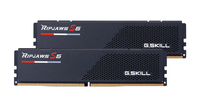DDR5 NON-ECC
( number of products: 53 )

Memory RAM 1x 16GB Crucial NON-ECC UNBUFFERED DDR5 4800MHz PC5-38400 UDIMM | CT16G48C40U5


Memory RAM 2x 16GB Crucial NON-ECC UNBUFFERED DDR5 4800MHz PC5-38400 UDIMM | CT2K16G48C40U5


Memory RAM 2x 8GB Crucial NON-ECC UNBUFFERED DDR5 4800MHz PC5-38400 UDIMM | CT2K8G48C40U5


Memory RAM 1x 32GB Crucial NON-ECC UNBUFFERED DDR5 4800MHz PC5-38400 UDIMM | CT32G48C40U5


Memory RAM 1x 8GB Crucial NON-ECC UNBUFFERED DDR5 4800MHz PC5-38400 UDIMM | CT8G48C40U5


Memory RAM 1x 16 GB Kingston NON-ECC UNBUFFERED DDR5 4800MHz PC5-38400 UDIMM | KVR48U40BS8-16


Memory RAM 1x 16 GB Hynix NON-ECC UNBUFFERED DDR5 4800MHz PC5-38400 UDIMM | HMCG78MEBUA084N


Memory RAM 1x 8 GB Hynix NON-ECC UNBUFFERED DDR5 4800MHz PC5-38400 UDIMM | HMCG66MEBUA081N


Memory RAM 1x 8 GB Samsung NON-ECC UNBUFFERED DDR5 4800MHz PC5-38400 UDIMM | M323R1GB4BB0-CQK


Memory RAM 1x 16 GB Samsung NON-ECC UNBUFFERED DDR5 4800MHz PC5-38400 UDIMM | M323R2GA3BB0-CQK


Memory RAM 1x 32 GB Samsung NON-ECC UNBUFFERED DDR5 4800MHz PC5-38400 UDIMM | M323R4GA3BB0-CQK


Memory RAM 1x 8 GB ESUS IT NON-ECC UNBUFFERED DDR5 4800MHz PC5-38400 UDIMM | ESUD54800US16/8G


Memory RAM 2x 16GB Corsair NON-ECC UNBUFFERED DDR5 4800MHz PC5-38400 UDIMM | CMK32GX5M2A4800C40


Memory RAM 2x 16GB Corsair NON-ECC UNBUFFERED DDR5 5200MHz PC5-41600 UDIMM | CMK32GX5M2B5200C40


Memory RAM 2x 16GB Corsair NON-ECC UNBUFFERED DDR5 5600MHz PC5-44800 UDIMM | CMK32GX5M2B5600C36


Memory RAM 2x 16GB Corsair NON-ECC UNBUFFERED DDR5 5200MHz PC5-41600 UDIMM | CMT32GX5M2B5200C40


Memory RAM 1x 8 GB Patriot NON-ECC UNBUFFERED DDR5 4800MHz PC5-38400 UDIMM | PSD58G480041


Memory RAM 1x 16 GB Patriot NON-ECC UNBUFFERED DDR5 4800MHz PC5-38400 UDIMM | PSD516G480081


Memory RAM 1x 32 GB Patriot NON-ECC UNBUFFERED DDR5 4800MHz PC5-38400 UDIMM | PSD532G48002


Memory RAM 1x 32 GB ESUS IT NON-ECC UNBUFFERED DDR5 4800MHz PC5-38400 UDIMM | ESUD54800UD8/32G


Memory RAM 1x 16 GB ESUS IT NON-ECC UNBUFFERED DDR5 4800MHz PC5-38400 UDIMM | ESUD54800US8/16G


G.SKILL Ripjaws S5 DDR5 32GB 2x16GB 6000MHz CL30 1.35V XMP 3.0 black F5-6000J3040F16GX2-RS5K


Memory RAM 1x 16 GB Samsung NON-ECC UNBUFFERED DDR5 5600MHz PC5-44800 UDIMM | M323R2GA3DB0-CWM


Memory RAM 1x 8 GB Samsung NON-ECC UNBUFFERED DDR5 5600MHz PC5-44800 UDIMM | M323R1GB4DB0-CWM


Memory RAM 1x 16GB Hynix NON-ECC UNBUFFERED DDR5 4800MHz PC5-38400 UDIMM | HMCG78AEBUA084N


Memory RAM 1x 16 GB Hynix NON-ECC UNBUFFERED DDR5 4800MHz PC5-38400 UDIMM | HMCG78AEBUA081N


Memory RAM 1x 16 GB Samsung NON-ECC UNBUFFERED DDR5 5600MHz PC5-44800 UDIMM | M425R2GA3PB0-CWM
- 1
- 2
DDR5 RAM memory
RAM is one of the key components of your computer that must be compatible with your device's motherboard. With a certain number of motherboard slots, you can easily increase your computer's performance by adding or replacing a RAM die. DDR5 is the successor to DDR4 technology, which has been waited for quite a long time. However, the new RAM dice are created with future-proofing in mind, so to take advantage of them, your hardware must be equipped with a next-generation motherboard.
DDR5 vs. DDR4 - what's the difference?
DDR4 RAM dice are currently the most popular version of RAM, featuring a good combination of key performance and energy efficiency. It is characterised by higher clocking, up to 3200 MHz and good bandwidth, while reducing power consumption to the 1.05-1.2 V range. DDR4 dice with the lowest possible CL parameter (CAS latency) guarantee minimum latency in relation to the time from sending a request to reading data.
DDR5 is the latest technology that involves increasing hardware performance. Therefore, it started by increasing the communication channels. DDR4 RAM dice had each module assigned a single channel, in DDR5 dice they are dual channels, assuming the same data transfer bandwidth. With this solution, instead of using a DDR4 dual channel bone, you can use a single DDR5 bone. If, on the other hand, you decide to go with dual channel DDR5, you will gain a quad channel mode previously unavailable in standard solutions.
DDR4 dice could feature ECC - Error Correction Code - which allowed real-time capture of errors within bits and replacement, thus contributing to the stability of the hardware, unfortunately at the expense of performance. DDR5 dice also offer a choice of non-ECC or ECC versions, depending on the intended use.
DDR5 memory - what parameters does it offer?
The new DDR5 RAM technology is a long-awaited revolution. First of all, DDR5 dice offer significantly larger capacities - up to 2 TB in total. The clock frequency for DDR5 dice reaches up to 7200 MHz. The new RAM dice are equipped with 288 pin connectors. However, higher performance means more heat generation, which is why DDR5 RAM dice can have suitable heatsinks to ensure good passive cooling.
Energy efficiency in the case of DDR5 has been increased in relation to the DDR4 RAM version - the dice operate at 1.1V, which makes them suitable for server applications where continuous, long-term operation of the device requires energy optimisation. One of the most important parameters of RAM memory is CL (CAS latency), which indicates the time between sending a request and reading data.
You want to fit a RAM to your device, but you're not sure how to choose a new DDR5 RAM? Write to us - our consultants will be happy to help you choose the right module.





